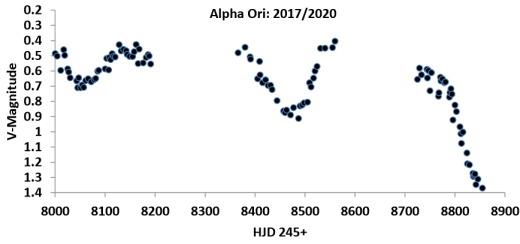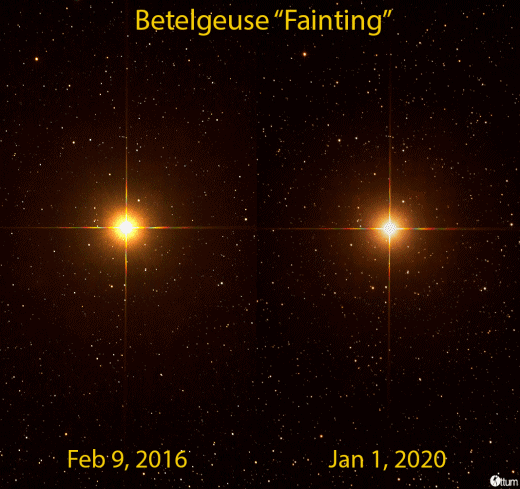 |
| Betelgeuse ligger 600 ljusår från jorden i Orions stjärnbild. |
One day, perhaps in our lifetimes, perhaps a million years
from now, the red giant Betelgeuse will dim a little–and then explode. The resulting supernova will rival the full Moon and cast shadows after dark, completely transforming the night skies of Earth. No wonder astronomers are closely tracking the current "fainting of Betelgeuse."
"Fainting" is an actual astronomical term. It means dimming, the opposite of brightening. And right now, Betelgeuse is definitely fainting.
Edward Guinan of Villanova University and colleagues caused a sensation among astronomers last month when they reported "[Betelgeuse] has been declining in brightness since October 2019, now reaching a modern all-time low of V = +1.12 mag on 07 December 2019 UT. Currently this is the faintest the star has been during our 25+ years of continuous monitoring."
Little did they know when they issued their telegram in December that Betelgeuse was about to become even fainter. “On 06 January 2020 UT, the magnitude of Betelgeuse was V = +1.37,” reports Guinan. That’s ~20% dimmer than the "modern all-time low" registered the month before.
This 3-year plot of the Villanova team’s data shows Betelgeuse’s rapid decline:

The horizontal axis is Heliospheric Julian Date (HJD). For reference, Jan. 6, 2020, the date of the most recent measurement, has an HJD of 2458855.
The fainting is easy to see with the naked eye. Not long ago, Betelgeuse was the 10th brightest star in the sky. Now it is the 21st. Observers of Orion rising in the east after sunset can’t help but notice that the Hunter’s shoulder is dimmer than it used to be.
Astronomers have long known that Betelgeuse is on the precipice of an energy crisis. It's about to run out of fuel in its core. When that happens, the star will collapse and rebound explosively, producing the first bright supernova in the Milky Way since 1604. Experts in stellar evolution believe Betelgeuse could die at any time during the next million years–a blink of an eye on time scales of astronomy.
Does the current dimming herald that final blast? Probably not. Betelgeuse is a slowly variable star, and this is probably no more than an episode of deeper-than-usual dimming. Of course, one day astronomers will think the same thing … and then the night sky will change forever.
